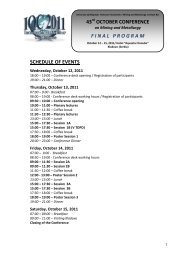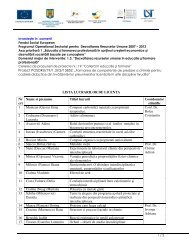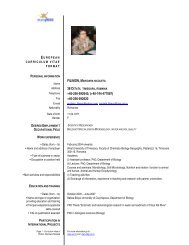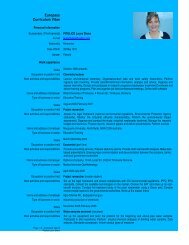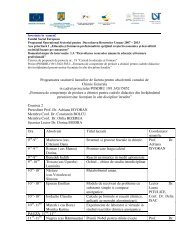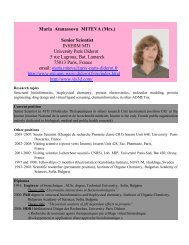rezumatele tezelor de doctorat susÈinute în anii 2009 â 2010
rezumatele tezelor de doctorat susÈinute în anii 2009 â 2010
rezumatele tezelor de doctorat susÈinute în anii 2009 â 2010
- No tags were found...
You also want an ePaper? Increase the reach of your titles
YUMPU automatically turns print PDFs into web optimized ePapers that Google loves.
UNIUNEAEUROPEANĂGUVERNUL ROMÂNIEIMINISTERUL MUNCII, FAMILIEI ŞIPROTECȚIEI SOCIALEAMPOSDRUFondul Social EuropeanPOS DRU2007-2013Instrumente Structurale2007-2013Investeşte în oameni!FONDUL SOCIAL EUROPEANProgramul Operaţional Sectorial pentru Dezvoltarea Resurselor Umane 2007 – 2013OIPOSDRUUNIVERSITATEADE VEST DINTIMIŞOARAOne of the most important <strong>de</strong>velopments in technology, which <strong>de</strong>termined the implementation ofenzymatic biotransformations at industrial level, was the enzyme immobilization. The sol-gel technique is aversatile process that makes possible to obtain materials with different chemical properties of the internalsurface. Since enzymes are very different in function and structure, there isn’t, until now, a more appropriate andmore generic process for enzyme immobilization. The sol-gel technique has many and varied applications inbiocatalysis, biosensors, controlled drug release, obtaining biomaterials with medical applications. In the presentPhD thesis two of these applications are approached, namely those in biocatalysis and biosensors, choosing asmo<strong>de</strong>l-enzymes α-amylase, amyloglucosidase and glucose oxidase, enzyme with multiple and diverseapplications and relatively not expensive.Different sol-gel methods, namely two-steps and one step techniques, were used and compared toobtain inorganic or hybrid silica matrices. In these methods were used different precursors (tetraethoxysilane(TEOS), tetrametoxysilane (TMOS), methyltriethoxysilane (MTES), phenyltriethoxysilane, vinyltriacetoxysilane,tetrakis(2-hydroxyethyl)orthosilicate (THEOS)), catalysts (HCl, NH3, NaF), homogenization agents (ethanol andisopropanol) and additives (polyvinyl alcohol, polyethylene glycol). Another immobilization method used was theentrapment/<strong>de</strong>position technique. In this technique, the enzyme was immobilized by sol-gel method and beforethe gelation occurred, different inorganic supports were ad<strong>de</strong>d (celite, zeolite, Al2O3, TiO2, purolite, white andred ceramic).The aim of these studies was to improve the biochemical and physicochemical characteristics ofdifferent sol-gel matrices. Thus, mesoporous matrices, which allow a faster internal diffusion of the substrate tothe entrapped enzyme and consequently a higher activity of the immobilized enzyme, were obtained by usingtemplating agents, as D-glucose, and by lowering the aging and drying temperature. The textural properties ofthe silica mesoporous xerogels were <strong>de</strong>termined from their N2 adsorption/<strong>de</strong>sorption isotherms. The specificsurface area, the pore size distribution, the total pore volume were measured. From the SEM images of thesematrices it can be observed a three-dimensional porous network, uneven, composed of silica particles ofirregular shapes and sizes and large differences in their sizes, differences that are responsible for the unequaldistribution of pores.The immobilization of commercial, purified enzymes was followed by the sol-gel entrapment of amicrobial enzymatic preparation, with amylasic and amyloglucosidasic activity, obtained by submergedfermentation of a local strain, Bacillus globigii amy+ CMIT 1.4. The strain selection was achieved by testing fourBacillus microbial strain, three of Bacillus subtillis and one of Bacillus globigii. The best results were obtained inthe case of the Bacillus globigii strain. The enzymatic preparation was entrapped in matrices based on TEOS,TMOS and MTES:TEOS 1:1. The best results (highest activity and yield) were obtained using TEOS asprecursor. Thus, a new enzymatic preparation, with properties similar to the commercial products, was obtained.The second direction of the research has focused on obtaining potentiometric glucose biosensorsbased on glucose oxidase (GOx). The enzyme was immobilized on the sensing surface of a glass pH-electro<strong>de</strong>using different techniques: enzyme <strong>de</strong>posited on cellophane, cross-linked with glutaral<strong>de</strong>hy<strong>de</strong> or entrapped insilica gel, using, for the first time in the case of potentiometric biosensors based on GOx, tetrakis(2-hydroxyethyl)orthosilicate (THEOS) as precursor. The glucose oxidase immobilization led to the improvement ofthe biosensors sensitivity.A review of experimental and theoretical data show that sol-gel technique leads to the obtaining ofheterogeneous biocatalysts, with enhanced activity and increased stability.293POSDRU 21/1.5/G/38347”Parteneriat local pentru ridicarea nivelului şcolilor doctorale şi valorificarea potenţialului uman din cercetare îndomenii prioritare ale etapei posta<strong>de</strong>rare a României la UE”




